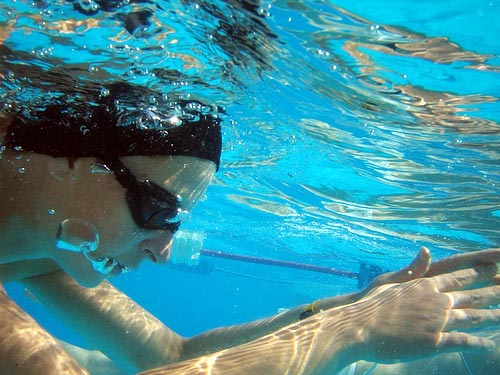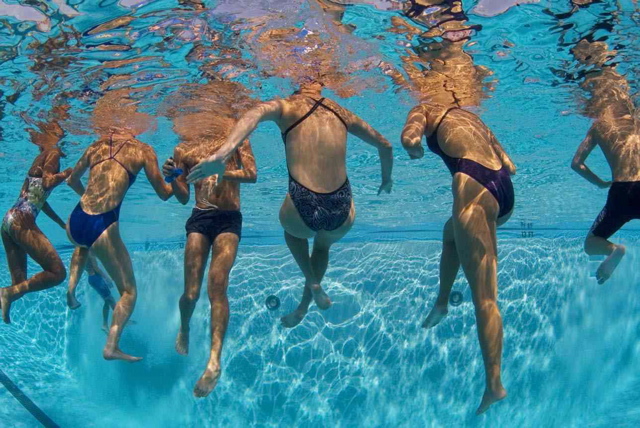In preparing for your open water certification class, there is one very important area that cannot be overlooked – the ability to swim. You may think, “Are you serious?” but it’s true. I have watched people sign up for Scuba classes who can’t swim, or maybe learned to swim as a kid, and assumed they could resume swimming like a fish after years away from the water.
It pains us as instructors, after watching how hard you’ve worked to prepare for your class, to then take you in the pool and make the horrific discovery that you cannot pass the swim test. This is hard on everyone. We want you to do well, we want you to pass, but we ultimately are responsible for your safety, and we know what awaits you in the ocean. Yes, your BCD can help to keep you afloat on the surface, but it is not meant to be used as a life preserver. What if you need to take it off? What if you have to do a long surface swim, or you have a malfunctioning BCD, or perhaps a dive buddy has trouble and needs your help? What if the ocean surface is choppy with swells? What if you have to take off your BCD and do a surface swim? It just comes down to the fact that you are not safe to yourself or your buddy if you are not a sound swimmer.

A typical open water class goes like this. You go through orientation, you read the materials, do your knowledge reviews, sit through your first class session and pass the quizzes. Then, off to the pool we go. We assemble gear and send you into the pool for your swim test. This typically involves swimming 200 yards (8 lengths of the pool) without stopping, touching the bottom or hanging onto the sides. It is not a timed test, so we encourage everyone to go slow and pace themselves. After completing the swim and a brief rest for a couple of minutes, we move on to treading water on the surface for 10 minutes. No dead man’s float, your face must be above the water. We as instructors carefully watch from the pool edge to monitor everyone’s progress. The variety of techniques of swimming are always intriguing. Who would have thought there were so many ways to dog paddle? In shallower pools I’ve seen people actually jogging across the bottom. Did you really think we wouldn’t notice? This process can be quite painful for everyone involved, because your instructors know how much this means to you, and we so badly want you to pass, but short of words of encouragement there is not a lot we can do.
However, you can prepare yourself by practicing on your own time prior to coming to Scuba class, especially if you just thought, “jogging across the bottom, Brilliant!” Here are descriptions of techniques and some simple tips:
Swimming
Side stroke – Your body is angled to the side and your head remains out of the water. Arms stretch apart, one reaching forward and the other reaching behind, then meet together. Legs move in a frog kick, or whip kick, where they bend and then whip around to a straight position. Strap on your flower swim cap and go!
Breast stroke – Similar to the side stroke, but your body is positioned at a forward downward angle. Make a heart-shaped motion with your arms where the point is in front of your body and the top of the heart is at your chest. The legs do the frog kick.
Front Crawl – This is what most people choose and what you probably learned in swim lessons. Ideally you want your body to float in a horizontal position while your legs and arms propel you through the water. Arms move alternately in a windmill type motion, reaching far forward and then making an ‘S’ shape through the water. Breathing is done to the side or head is held above the water like a lifeguard (much more difficult). Legs scissor kick from the hips. Try to get your body in as horizontal of a position as possible, it will be much easier to propel yourself across the surface. When your hips sink, it requires more energy to move through the water.
Freestyle – Well, it’s just that, free style. Anything that gets you across the pool goes!

Treading water
What to do with your arms . . .
By moving your arms slowly back and forth just below the surface you can help to keep your body afloat. By slightly cupping your hands and angling them downward you maximize the amount of water being moved. This is known as sculling.
And your legs . . .
There are three types of kicks most commonly used; flutter kick, eggbeater and frog kick.
Flutter kick – Legs remain straight and scissor back and forth from the hip. We don’t recommend this one as you exhaust yourself quickly and it is not efficient.
Eggbeater — Legs are bent and rotate alternately, right leg counter-clockwise and left leg clockwise. This is the kick that water polo players use. It is the most efficient kick and allows them to maintain a level position in the water. However, it is difficult to master and takes time and practice.
Frog kick – With this kick the legs slowly bend up into the body and then whip around. This is the breast stroke kick and is the kick most people use, it is fairly easy and will keep you afloat for 10 minutes!
You want this. You’ve worked hard for it! So, prepare yourself for both the physical and educational portions of this class. If it’s been a while since you were last in the pool, go take a dip. See where you are. If you are confident in your water skills, but lack endurance, start building on it with a regular schedule of swimming. If your water skills are lacking, consider some swim lessons. Monitor your progress so that you can meet the PADI open water requirements of treading water for 10 minutes and swimming 200 yards. When you show up for your first pool session, you will be able to focus on other skills and equipment issues, then jump in and effortlessly pass your swim test. We will all feel proud. Check!
(editor: francesca.koe@deeperblue.com)
